|
GETAC V100
Light, compact, yet fully rugged notebook convertible with superbright display
(by Conrad H. Blickenstorfer -- view PDF version)
If your job or application requires a very compact, lightweight rugged computer that can take a beating AND function both as a standard notebook and a tablet computer, the GETAC V100 can do all this, and more.
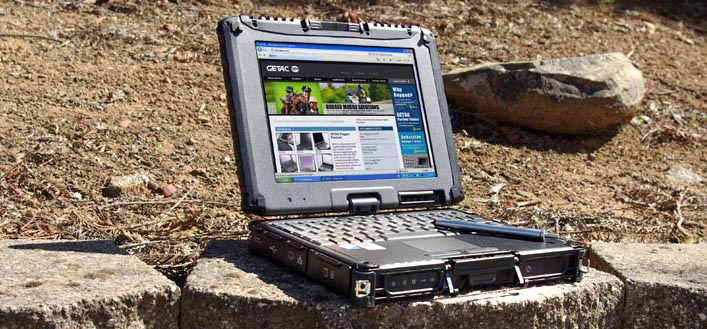
On the image below you can see how the notebook convertible principle works (click on the picture for a larger version): the display part of the notebook has a special hinge that lets you rotate it and then fold it down, with the LCD screen facing up. This way you have the best of both worlds -- a regular notebook when you need it, and a handy slate computer when that is required. It adds a great deal of flexibility, and that is what this GETAC computer is all about.
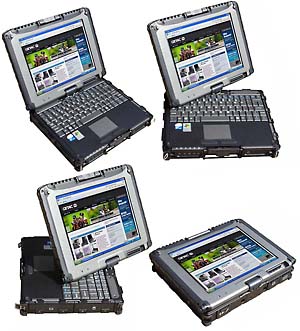
Before we go into describing the GETAC V100, a few words about this type of computer and what it is meant to be. In the early 1990s, applying computer technology to the pen and paper clipboard metaphor intrigued the industry and gave rise to a first generation of pen computers. Most were slates that sought to combine computing power with the ease of use and familiarity of paper and pencil. Such slate computers could be carried around easily, and they were ideally suited for data collection, the filling out of electronic forms, and any task where a keyboard was not needed or got in the way. This first generation of pen computers was not commercially successful but the technology lived on in vertical markets and applications.
Microsoft revived pen computing in 2002 with the introduction of the Tablet PC -- computers with an active digitizer and a special version of the Windows operating system. Early Tablet PC concepts were all slates, but even before the new platform was officially introduced, the Tablet PC "convertible" was added as sort of a hybrid between a notebook and a slate. The GETAC V100 is a ruggedized and much more technologically advanced version of those early Tablet PC convertibles.
Why did GETAC, founded by General Electric-Aerospace and Mitac Group of Taiwan in 1989, add the V100 to its lineup? Because the company has been a pioneer in ruggedized mobile and portable innovation for military and other demanding markets worldwide and having a small, light convertible fills an important niche. With almost 20 years of experience in building water-tight housings and thermally optimized no-vent equipment that is resistant to shock and vibration and can accommodate operation in very wide temperature ranges as well as handle dust, sand, snow, water, hazardous materials and other environmental conditions, we expected a competent and polished product. Does the V100 deliver?
What do you get with the GETAC V100?
The GETAC V100 is a notebook that provides flexibility and computing power in a compact package. Its footprint of 12.2 x 8.7 inches is barely larger than that of a pad of paper. Despite its inherent ruggedness, it's under two inches thick and weighs less than five pounds. A 1.2GHz Ultra Low Voltage Intel Core Duo U2500 processor combines good performance with long battery life (processor was updated to a 1.2GHz Core 2 Duo U7600 on 9/2008, and to a 1.4GHz Core 2 Duo SU9400 on 6/2009). And customers can select from a large variety of wireless options and several display technologies. The V100 is available with a standard touch screen LCD (running Windows XP) or one with an active digitizer (using the XP Tablet PC 2005 Edition). There are also two screen sizes. Our review machine had the 10.4-inch XGA (1024 x 768 pixel) display, but a model with a 12.1-inch WXGA (1280 x 800 pixel) wide-screen is also available. And GETAC offers an outdoor viewable screen option as well.
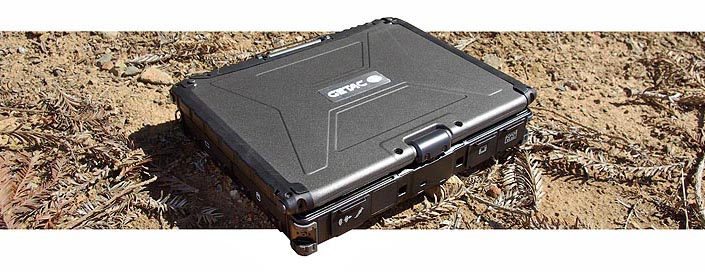
Taking a closer look at the V100: exemplary design
Good industrial design never hurts, and the V100 is undoubtedly a ruggedly handsome device. Its case is made of magnesium alloy with hardened plastics along the edges and small rubber bumpers in the corners for extra impact protection. The plastic parts are black, the magnesium alloy finished in a military-style dark gray. Form very much follows function on this machine. Small black Philips screws are left visible, structural elements likewise, and it all comes together in a design that exudes toughness and purpose but also looks good enough to win design awards. GETAC did an excellent job here.
Good industrial design, however, goes beyond good looks. It means attention to detail, ergonomics, ease of use, and the application of common sense. Looking at some of the details of the V100 shows that its designers spent time thinking things through. Some examples:
Even though this is a very compact notebook, the V100 has a full-size, 100%-scale QWERTY keyboard layout. I cannot overstate the importance of that. We all grow up with keyboards, and whether we touch-type or just hunt-and-peck, we're used to the exact size of a standard keyboard. Throw that off by even a small fraction and things don't feel right and typing becomes frustrating. Over the years we've had all too many compact notebooks in our lab that all felt like toys because their designers inexplicably compressed the QWERTY part of the keyboard even though there might have been enough space. Go figure.
GETAC did not make that mistake. The V100's keyboard is exemplary. It's standard size, has large white letters on black, and there is excellent tactile feedback. All keys are clearly marked without being cluttered. Functions assigned to keys are labeled in blue. A good keyboard can make the difference between a useful computer and one that is a pain, and GETAC certainly aced it.
That said, the above applies to the standard keyboard our tester came with. Customers with special environmental needs can order a waterproof membrane keyboard, or one with a backlight for use at night.
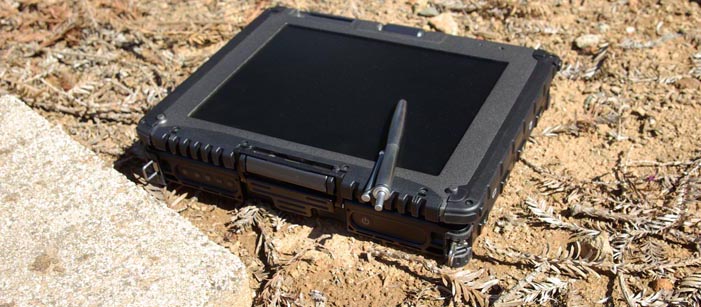 Attention to detail is also visible in other areas. Take the cover latch, for example. Almost all notebook computers have some sort of latch or mechanism that makes sure it doesn't open inadvertently. There are many different ways of securing the display case to the bottom part. There are springloaded latches, levers, snaps, guides or bolts. With a notebook convertible it gets a bit more complicated because you need to be able to secure the display whether faces up or down. How did GETAC accomplish this task?
Attention to detail is also visible in other areas. Take the cover latch, for example. Almost all notebook computers have some sort of latch or mechanism that makes sure it doesn't open inadvertently. There are many different ways of securing the display case to the bottom part. There are springloaded latches, levers, snaps, guides or bolts. With a notebook convertible it gets a bit more complicated because you need to be able to secure the display whether faces up or down. How did GETAC accomplish this task?
They used an intricate tension-loaded latch that, once secured, will absolutely keep the computer from opening on its own. The latch works the same way whether the LCD is facing up or down. Securing the latch requires a conscious effort on behalf of the user; you don't just close the lid. That's good because sometimes you may not want the lid to be secured, like when you need to open and close it frequently or when you wear gloves that would make it difficult to operate a small latch or release. It is an interesting solution that makes sense.
Another convincing design detail is the way the V100's ports and connectors are covered and protected. Many rugged devices use a single door to cover a whole bank of connectors. That makes little sense as you often need just one, so why expose the rest? The V100 has separate rubber/plastic covers for almost every port. An ear on top serves to open a cover. To close one you push it in and friction keeps it in place. Each is clearly marked with a large white icon. Should one break or rip off, it is easily replaced. Just undo two Philips screws to take the old one off and replace it.
Next on the list of remarkably well-designed details is the rotating display hinge. Quite obviously it needs to be tough and sturdy, and it is. But it also needs to solve a vexing characteristic of this sort of hinge: if you use a pen or stylus to navigate or tap the display while the computer is used as a notebook, the display must not flex back or else using the pen becomes an exercise in frustration. Almost all notebook convertibles suffer from that syndrome. The V100 does not. Somehow the GETAC designers found a way to make the hinge stiff enough to preclude virtually all flex.
Yet another good design solution is the stylus that comes with the touch screen version of the V100. It telescopes from 2-1/2 to 5 inches, can be tethered to the computer so you don't lose it, and it neatly fits into its own garage below the LCD. That way you can see it and, if it isn't tethered, the likelihood of losing it is much lower.
Ports, buttons, and lights
Like all GETAC computers, the V100 is a well connected machine. Almost everything you're likely to need is right on the computer -- no need for a port replicator or special dock (though both are available). Let's take a look at all sides.

Above you see the front of the V100. You can see the above-described latch, or clasp, and how it very securely holds the display case in place. The little circle top center is the V100's digital camera. It is a 1.3 megapixel CMOS imager that rotates 225 degrees so it can be used for video conferencing, and taking pictures both in notebook and in tablet mode. The power button is on the right side of the system unit. The left side has a series of push button controls. There is a hardware LCD brightness up/down rocker as well as three buttons you commonly find on Tablet PCs: screen rotation, onscreen keyboard, and the "security button" that does a alt-ctrl-del. On the left and right bottom corners are handstrap rings. The strap itself has karabiner clasps for quick release.
Along the left front of the V100 is a row of device indicator lights. They show AC power, battery charge, hard disk access, scroll lock, num lock and caps lock.

The backside (above) has, from left to right, separate audio output and microphone connectors, a Kensington lock, and standard VGA and serial connectors. The VGA port can optionally be replaced by a second RS232 connector.
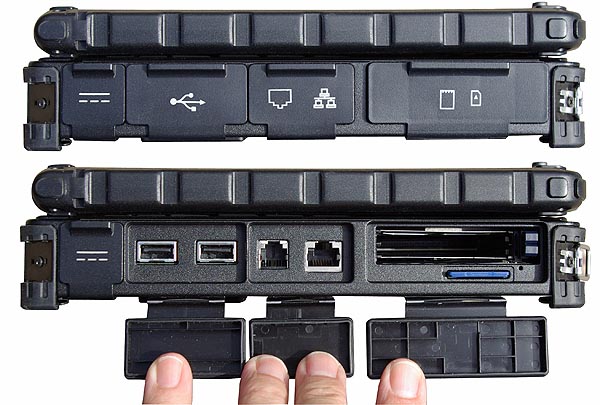 Above is the left side of the V100, with ports closed and opened. You can see the port covers with their ears on top and the large white icons that indicate what port or connector is beneath. From left to right are the power connector (covered), two USB 2.0 ports, modem and gigabit LAN jacks, and the card slot compartment that can accommodate two PC Type II cards or one Type III card (changed to one PC Card and one ExpressCard slot in June of 2009). Below that is a SD Card slot. Customers can sacrifice one Type II slot and get a Smart Card reader instead.
Above is the left side of the V100, with ports closed and opened. You can see the port covers with their ears on top and the large white icons that indicate what port or connector is beneath. From left to right are the power connector (covered), two USB 2.0 ports, modem and gigabit LAN jacks, and the card slot compartment that can accommodate two PC Type II cards or one Type III card (changed to one PC Card and one ExpressCard slot in June of 2009). Below that is a SD Card slot. Customers can sacrifice one Type II slot and get a Smart Card reader instead.
 The right side, finally, provides access to the V100's battery and hard disk compartments. Both are covered and sealed by hinged doors secured by two latches each so there is no way that they accidentally open. The Toshiba hard disk is mounted in a separate protective cage heavily cushioned with shock-absorbing materials. The standard Li-Ion battery provides 58 watt-hours; an optional 87 watt-hour battery is also available. The batteries are "smart" and come with calibration utilities and "gas gauges" on the packs that show charge in 25% increments.
The right side, finally, provides access to the V100's battery and hard disk compartments. Both are covered and sealed by hinged doors secured by two latches each so there is no way that they accidentally open. The Toshiba hard disk is mounted in a separate protective cage heavily cushioned with shock-absorbing materials. The standard Li-Ion battery provides 58 watt-hours; an optional 87 watt-hour battery is also available. The batteries are "smart" and come with calibration utilities and "gas gauges" on the packs that show charge in 25% increments.
Communications
Communication is key in today's mobile computers, and the V100 is well equipped. For wired network connectivity there is gigabit Ethernet (10/100/1000base-T). On the wireless side you get Bluetooth EDR (Enhanced Data Rate) Version 2.0 and the Intel PRO/Wireless 3945 chipset that provides 802.11a/b/g WiFi (changed to Intel WiFi Link 4965AGN in June of 2009). A GPS module is optional (you can have either GPS or the camera, but not both). The V100 can also be equipped with 3G cellular voice/data radios. CDMA 2000 1× EV-DO is available via a Sierra Wireless module. On the GSM side of things, 3G UMTS (Universal Mobile Telecommunication System) technology supports the W-CDMA/HSDPA interface. The V100 has room for internal antennas for those Wireless Wide Area networks inside the black protective end caps to the left and right of the LCD case. There is no IR port; that technology has now largely been replaced by Bluetooth.
Ruggedness
GETAC generally classifies the V100 as "rugged -- vibration, dust, water and temperature resistant. The terms "durable," "semi-rugged," "rugged" and "ultra-rugged" are relative and so it is usually a matter of perusing the environmental specifications and test results and then determining if a device fits the intended application. Here's where the GETAC V100 fits in:
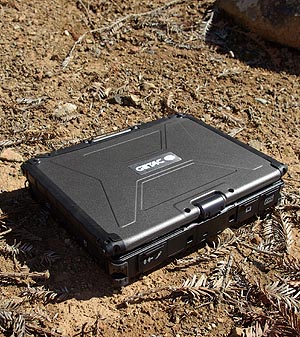 IP ratings refer to Ingress Protection standards for electrical enclosures, with the first number describing the protection level against solids and the second protection against liquids. The V100's original IP54 rating meant the computer was almost totally protected against dust intrusion, and it also protected against water spray from all directions. Sealing was increased to IP65 level, indicating total protection against dust and protection against low pressure water jets from all directions.
IP ratings refer to Ingress Protection standards for electrical enclosures, with the first number describing the protection level against solids and the second protection against liquids. The V100's original IP54 rating meant the computer was almost totally protected against dust intrusion, and it also protected against water spray from all directions. Sealing was increased to IP65 level, indicating total protection against dust and protection against low pressure water jets from all directions.
In terms of temperature resistance, a standard V100 can operate between temperatures of 32 to 131 degrees Fahrenheit. A low temperature option allows operation in as low as 4 degrees Fahrenheit. The computer also passed non-condensing humidity testing up to 95% and can operate in altitudes up to 15,000 feet (and obviously in aircraft with pressurized cabins).
The device is RoHS-compliant. RoHS stands for Restriction of Hazardous Substances and regulates the use of certain hazardous substances in electronic equipment. The RoHS standard is fully implemented in Europe, with lesser restrictions applying in the US.
Shock, vibration, drop and ESD resistance are all tested according to MIL-STD-810F and other relevant regulatory procedures. Not all results are in the promotional literature or owner's manual, so inquire with GETAC for specifics.
On June 2nd, 2009, GETAC announced that the V100 had been UL 1604 certified by Underwriters Laboratories, an independent lab that tests products to ensure public safety. The optional UL 1604 certification allows safe, spark-free use of the V100 in potentially explosive environments typically found in the oil and gas, petrochemical, aviation and other industries.
Security
Data and access security is becoming an every more important issue in mobile computing. The V100 offers TPM 1.2 functionality to store secured information. An optional Smart Card reader can be used to provide additional access security. A Kensington lock slot offers simple but effective defense against theft. We'd like to see a fingerprint reader option and a way to lock the removable hard disk bay.
Operating System
The V100 currently ships with either Windows XP Professional or with the XP Professional Tablet PC Edition 2005 for units equipped with an active digitizer. With its Mobile Intel 945GMS chipset, the V100 also runs Windows Vista.
Competition
Let's not beat around the bush. The Panasonic Toughbook CF-19 has occupied this very niche in the rugged mobile computing market for several years. Like all Toughbooks, it is a formidable machine, but it now has met its match in the new GETAC V100. Very similar in appearance, size, weight and functionality, the V100 meets or beats the Panasonic in almost every category. Wireless options are similar as are environmental specs and battery power. The GETAC comes with a quicker processor, a larger hard disk, faster LAN communication and it has two PC Card slots instead of just one. It is available in more different configurations and offers a 12.1-inch wide-screen version, which Panasonic does not. The Panasonic has an optional fingerprint scanner, but you can't get it with an integrated camera. It's a tough race, but one where GETAC offers a newer and more powerful machine.
September 2008 update: super-bright 1200 nits display
In September of 2008, GETAC announced that the V100 would get the company's exclusive Sunlight Readable Technology (SRT) first pioneered in the GETAC B300.
Sunlight-readability is rapidly becoming a major selling point in the rugged notebook sector. That makes sense as most rugged notebooks will likely see outdoor duty. Standard transmissive LCD displays, however, wash out in daylight. RuggedPCReview's technology editor, Geoff Walker, stated the following:
"There are really only two practical methods of making a notebook screen readable outdoors: (a) crank up the brightness (measured in nits, which is display-industry slang for "candela per meter squared", or cd/m2) to the point where the light emitted by the screen is sufficiently greater than the ambient light reflected by the screen, or (b) treat the surface of the screen so it reflects much less light, which again allows the emitted light to exceed the reflected light."
GETAC's solution employs both methods—increased screen brightness and circular polarization anti-reflectivity coatings—for superb sunlight viewability. A super-bright 1,200 nits LED-based display backlight replaces the older cold cathode fluorescent lamps (CCFLs) that are still commonly used in notebook displays. There are several advantages to an LED backlight: LEDs are less diffused, they are power-efficient, they are flexible and more reliable, and they allow mercury-free solutions.
How can GETAC offer such a strong backlight without adversely affecting battery life? We have not seen the upgraded V100, but if GETAC implemented the SRT display as in their rugged B300 notebook, by making the superbright setting accessible only via button push. It is actually too bright for indoor use, so you're not tempted to have it on all the time. And it is also not linked to the integrated lightmeter that can automatically adjust the backlight. This way you get the extra brightness when you need it, but you don't burn through the battery when you don't and don't have to resort to complex power-management schemes.
June 2009 update: enhanced performance and UL 1604 certification
On June 2nd, 2009, GETAC announced a technology update to the V100. The 1.2GHz Core 2 Duo U7600 processor was replaced with a quicker 1.6GHz Core 2 Duo SU9400. The SU9400 employs 45nm technology instead of the older chip's 65nm technology, enabling a higher clock rate, faster bus speed (800 vs. 533MHz), more L2 cache (3MB vs. 2MB) in a smaller package (22x22mm vs. 35x35mm) and better performance without using any more power (thermal design power stays at 10 watts). The complementing chipset is probably the "Cantiga" Intel GS45 with integrated GMA X4500HD graphics core.
Maximum RAM has been increased to 4GB, hard disks now come with capacities between 160 and 320GB, WiFi si potentially faster with the addition of 802.11 draft-N support, and the standard configuration now includes an ExpressCard slot (which likely replaces one of the PC Card slots.
The machine now also carries optional UL1604 certification for units that will operate in potentially explosive environments typically found in the oil and gas, petrochemical, aviation and other industries.
Based on RuggedPCReview.com's benchmark database, we expect the updated V100 to be between 25 and 50% faster than the predecessor version with probably the same or better battery life.
Summary
The V100 is GETAC's entry in the compact rugged mobile computer market. It is a small, lightweight notebook that can either be used as a standard laptop or, by rotating the display, as a Tablet PC slate.
Up-to-date technology includes an energy-efficient ultra-low voltage 1.4GHz Intel Core 2 Duo SU9400 processor, a large 160 to 320GB serial ATA hard disk, gigabit Ethernet, fast wireless PAN and WAN implementations, SD Card reader and an integrated camera.
Like all GETAC units, the V100 uses advanced thermal design to keep heat buildup at an absolute minimum. Heat pipes and the sturdy aluminum alloy case keep the computer cool and alleviate the need for a noisy fan.
Customers can select different 3G cellular data options, add an integrated GPS receiver, an optional Smart Card reader, and even opt for a 12.1-inch wide-format touch screen instead of the standard 10.4-inch touch display. The SRT sunlight-readable technology with its 1,200 nits LED backlight and circular polarizers is in a class by itself. There is also an active digitizer option.
In everyday use, the V100 excels thanks to an optimal balance between performance, long battery life, good ergonomics, silent operation, a full size keyboard and a high quality feel.
GETAC V100 highlights:
- Excellent industrial design with quality look and feel
- Convertible design allows use as notebook as well as Tablet PC slate
- Fan-less design for silent running, yet does not heat up
- Various display and digitizer options with superbright SRT sunlight-readable technology
- Compact size and light weight
- Each port and interface has its own protective cover
- Rugged enough for tough jobs
- Useful options: camera, large battery, 3G data networks
But keep in mind:
- No fingerprint scanner
- Somewhat complex cover latch
- No IrDA
– Conrad H. Blickenstorfer
GETAC V100 Specs
| Added/changed |
Added 9/24/2007, updated specs 4/1/2008, 9/8/2008, 6/2/2009, 3/25/2010
|
| Type |
Rugged notebook convertible
|
| Processor |
Intel Core 2 Duo SU9400 ULV 1.40GHz, 800MHz FSB, 3MB L2 cache |
| Thermal Design Power |
10 watts |
| OS |
Windows 7, Windows Vista Business (with XP Professional downgrade) or Windows XP Tablet PC Edition 2005 |
| Graphics Controller |
Intel GS45 with integrated GMA X4500HD graphics core |
| Memory |
1GB DDR2 533MHz, expandable to 4GB |
| Display |
10.4" XGA (1024 x 768) TFT or 12.1" WXGA (1280 x 800) with touch screen and Sunlight Readable Technology (SRT) with 1200 nits LED backlight. Optional active digitizer |
| Digitizer/Pens |
Pressure sensitive touchscreen; optional multi-touch touchscreen (glove type), optional dual mode touchscreen (pressure sensitive touchscreen and digitizer) |
| Keyboard |
82-key, 100%-scale waterproof membrane keyboard; optional waterproof rubber and backlight option |
| Storage |
Shock-mounted removable 160 - 320GB SATA |
| Slots |
1 PC Card Type II, optional 1 ExpressCard 34/54 (occupies Smart Card reader slot), 1 SD Card, optional smart card reader |
| Housing |
Full magnesium alloy case |
| Temperature |
32 to 131 degrees Fahrenheit; -4 to 131 low temp option |
| Humidity |
45% to 95% RH, non-condensing |
| Vibration |
According to IEC 68-2-6 / MIL-STD-810F, Method 514.5 |
| ESD |
According to IEC1000-4-2 |
| Certification |
UL1604 |
| Enclosure Class |
IP65 |
| Size |
11.2 x 8.7 x 1.9" (10.4" model); 13.0 x 8.7 x 1.9" (12.1" model) |
| Weight |
4.9 lbs. (10.4" model); 5.4 lbs. (12.1" model) |
| Power |
57.7 watt-hour Li-Ion smart battery (11.1V, 5,200mAh, optional 86.6 watt-hour Li-Ion smart battery (11.1V, 7,800mAh) |
| Communication |
10/100/1000Base-T Ethernet, 802.11a/b/g/draft-n (Intel WiFi Link 5300), Bluetooth 2.0 + EDR, GPS or camera; optional: CDMA 2000 1x EVDO (Sierra 5720) or WCDMA/HSDPA (UMTS)
|
| Interface |
1 or 2 Serial, 2 USB 2.0, External VGA, RJ-45, RJ-11, Microphone, Line out, Docking port, DC in, Integrated 225 degree reversible 1.3-megapixels camera |
Price |
Starting at US$3,550 |
| Contact |
GETAC us.getac.com |
|








